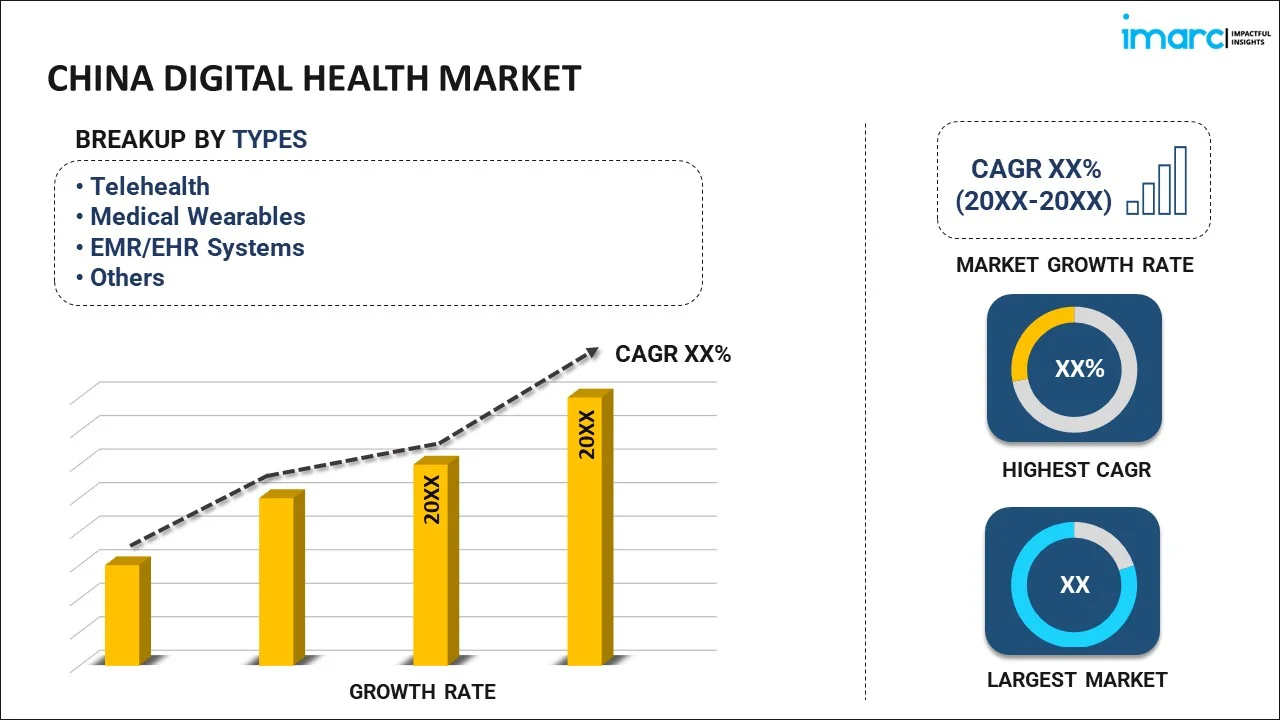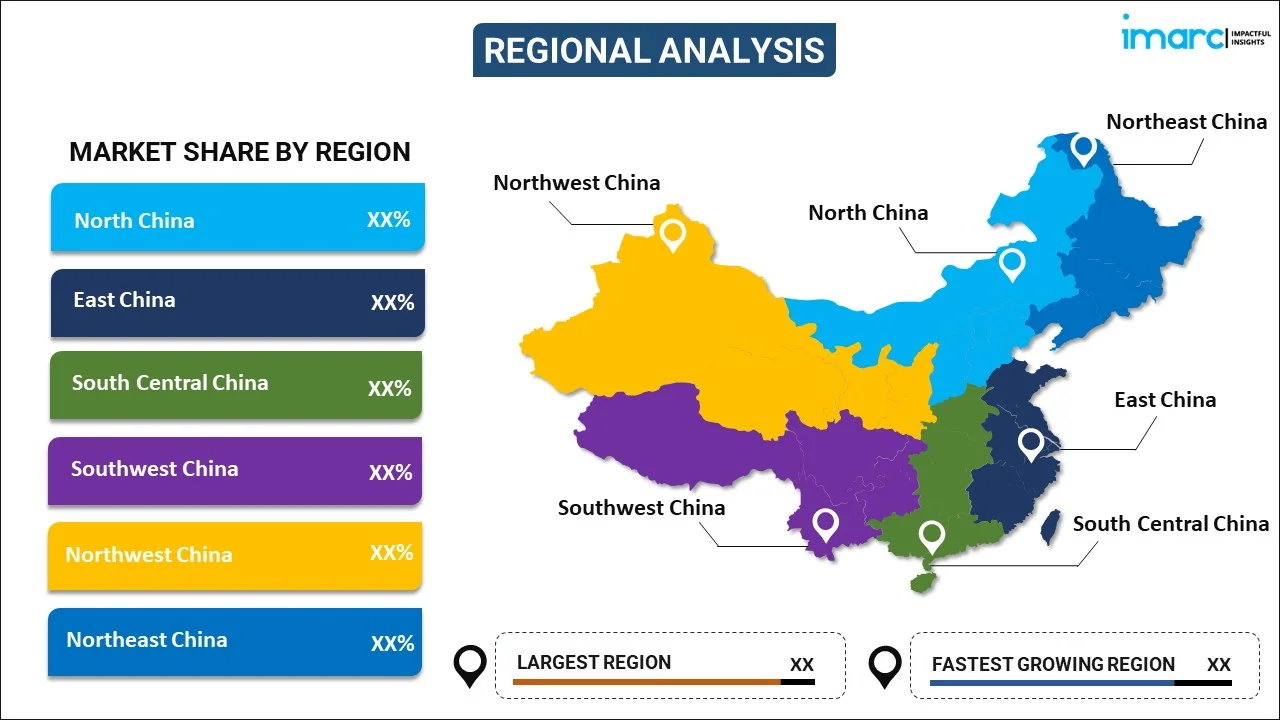
China Digital Health Market Report by Type (Telehealth, Medical Wearables, EMR/EHR Systems, Medical Apps, Healthcare Analytics, and Others), Component (Software, Hardware, Service), and Region 2024-2032
China Digital Health Market Overview:
The China digital health market is projected to exhibit a growth rate (CAGR) of 17.50% during 2024-2032. The market is thriving, driven by technological advancements, government support, and a growing demand for telemedicine, AI diagnostics, and health apps. It is further witnessing rapid growth with increased investment in digital healthcare infrastructure and innovative health tech solutions, enhancing accessibility and quality of care across the country.
|
Report Attribute
|
Key Statistics
|
|---|---|
|
Base Year
|
2023 |
|
Forecast Years
|
2024-2032
|
|
Historical Years
|
2018-2023
|
| Market Growth Rate (2024-2032) | 17.50% |
China Digital Health Market Trends:
Government Initiatives and Policies
The Chinese government is significantly boosting its digital health sector through various initiatives and policies. A key policy is the promotion of “Internet plus Healthcare” which integrates internet technologies with traditional healthcare services to improve accessibility and efficiency. This initiative facilitates online consultations, remote diagnostics, and digital management of health records. The COVID-19 pandemic led to a rise in telemedicine with China witnessing the approval of 2700 Internet hospitals and a user base of 363,000,000 for online medical services by the end of year 2022. The market size for Internet hospitals and online pharmacies reached approximately RMB 310 billion and RMB 250 billion respectively representing a year-on-year increase about 39% and 36%. The implementation of regulation on human genetic resources management aims to streamline the development and application of genetic technologies in healthcare. These regulations ensure ethical standards and data security while fostering innovation in precision medicine and genetic research. Together these factors are part of a broader strategy to modernize China’s healthcare system making it more accessible and technologically advanced.
Integration of AI and Big Data
Artificial intelligence (AI) and big data are important in revolutionizing healthcare delivery in China. AI is used for drug development by accelerating the identification of potential compounds and optimizing clinical trials. China is advancing it's a smart Chinese medicine with the establishment of CR-BU Joint Innovation Center on Smart Chinese Medicine. This collaboration between Hong Kong Baptist University and China Resources Research Institute of Science and Technology Aims to develop a chronic disease management system and conduct research on AI and big data in Chinese medicine. The initiative aligns with Chinese government’s focus on smart hospital construction and increasing R&D expenditure mainly in AI. The collaborative effort seeks to standardize and internationalize smart Chinese medicine contributing to the modernization of traditional Chinese medicine. In diagnostics, AI algorithms analyze medical images and data to detect diseases like cancer at early stages, further enhancing accuracy and speed. Personalized treatment plans are developed using AI to tailor therapies based on individual patient data, which, in turn, improves the final outcome. Big data enhances health management by aggregating vast amounts of health records, enabling predictive analysis to identify health trends and potential outbreaks. It also supports medical research by providing these comprehensive datasets for studying disease and developing new treatments.
China Digital Health Market News:
- In 2024, London-based telehealth company QuestPrehab signed an exclusive contract with IHSN Healthcare to deliver digital prehabilitation services to patients in China, focusing on pulmonary conditions. This pioneering initiative aims to improve patient outcomes and quality of life through digital prehab services. With plans to expand to other hospitals in China, QuestPrehab's scalable and cost-efficient digital platform offers a promising solution that doesn't require modifications to existing healthcare infrastructure.
- In 2024, China Medical University Hospital partnered with Google Cloud to utilize MedLM, a healthcare-specific generative AI, for cancer care. The AI assists in disease diagnosis, treatment planning, patient education, and medical research. CMUH aims to establish industry-leading healthcare AI models for the Chinese-speaking market and improve patient outcomes. Additionally, the hospital utilizes Google's AI accelerators for drug development and has implemented AI-powered medical services, such as the Intelligent Anti-Microbial System.
China Digital Health Market Segmentation:
IMARC Group provides an analysis of the key trends in each segment of the market, along with forecasts at the country level for 2024-2032. Our report has categorized the market based on type and component.
Type Insights:

- Telehealth
- Medical Wearables
- EMR/EHR Systems
- Medical Apps
- Healthcare Analytics
- Others
The report has provided a detailed breakup and analysis of the market based on the type. This includes telehealth, medical wearables, EMR/EHR systems, medical apps, healthcare analytics, and others.
Component Insights:
- Software
- Hardware
- Service
A detailed breakup and analysis of the market based on the component have also been provided in the report. This includes software, hardware, and service.
Regional Insights:

- North China
- East China
- South Central China
- Southwest China
- Northwest China
- Northeast China
The report has also provided a comprehensive analysis of all the major regional markets, which include North China, East China, South Central China, Southwest China, Northwest China, and Northeast China..
Competitive Landscape:
The market research report has also provided a comprehensive analysis of the competitive landscape in the market. Competitive analysis such as market structure, key player positioning, top winning strategies, competitive dashboard, and company evaluation quadrant has been covered in the report. Also, detailed profiles of all major companies have been provided.
China Digital Health Market Report Coverage:
| Report Features | Details |
|---|---|
| Base Year of the Analysis | 2023 |
| Historical Period | 2018-2023 |
| Forecast Period | 2024-2032 |
| Units | US$ Billion |
| Scope of the Report | Exploration of Historical Trends and Market Outlook, Industry Catalysts and Challenges, Segment-Wise Historical and Future Market Assessment:
|
| Types Covered | Telehealth, Medical Wearables, EMR/EHR Systems, Medical Apps, Healthcare Analytics, Others |
| Components Covered | Software, Hardware, Service |
| Regions Covered | North China, East China, South Central China, Southwest China, Northwest China, Northeast China |
| Customization Scope | 10% Free Customization |
| Post-Sale Analyst Support | 10-12 Weeks |
| Delivery Format | PDF and Excel through Email (We can also provide the editable version of the report in PPT/Word format on special request) |
Key Questions Answered in This Report:
- How has the China digital health market performed so far and how will it perform in the coming years?
- What has been the impact of COVID-19 on the China digital health market?
- What is the breakup of the China digital health market on the basis of type?
- What is the breakup of the China digital health market on the basis of component?
- What are the various stages in the value chain of the China digital health market?
- What are the key driving factors and challenges in the China digital health?
- What is the structure of the China digital health market and who are the key players?
- What is the degree of competition in the China digital health market?
Key Benefits for Stakeholders:
- IMARC’s industry report offers a comprehensive quantitative analysis of various market segments, historical and current market trends, market forecasts, and dynamics of the China digital health market from 2018-2032.
- The research report provides the latest information on the market drivers, challenges, and opportunities in the China digital health market.
- Porter's five forces analysis assist stakeholders in assessing the impact of new entrants, competitive rivalry, supplier power, buyer power, and the threat of substitution. It helps stakeholders to analyze the level of competition within the China digital health industry and its attractiveness.
- Competitive landscape allows stakeholders to understand their competitive environment and provides an insight into the current positions of key players in the market.
Need more help?
- Speak to our experienced analysts for insights on the current market scenarios.
- Include additional segments and countries to customize the report as per your requirement.
- Gain an unparalleled competitive advantage in your domain by understanding how to utilize the report and positively impacting your operations and revenue.
- For further assistance, please connect with our analysts.
 Inquire Before Buying
Inquire Before Buying
 Speak to an Analyst
Speak to an Analyst
 Request Brochure
Request Brochure
 Request Customization
Request Customization




.webp)




.webp)












